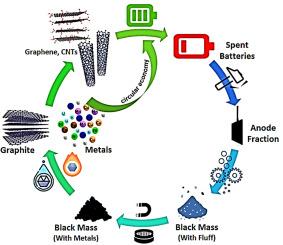废旧电池中可再生石墨和其他碳纳米材料的回收策略综述
IF 10
1区 环境科学与生态学
Q1 ENGINEERING, ENVIRONMENTAL
引用次数: 0
摘要
回收废旧电池可以解决有关石墨可用性和资源枯竭的经济和环境问题,因为对石墨的需求正随着指数级技术的增长而增长。各种各样的电池,包括一次电池(锰电池、碱性电池)和二次电池(锂离子电池、镍基电池、钒氧化还原液流电池、钠硫电池、铅酸电池、电化学电池和超级电容器),已被考虑作为石墨的来源。回收的石墨必须转化为可用的形式,如氧化石墨/氧化石墨烯,或进一步转化为还原氧化石墨烯,因为它通过热、化学和机械途径赋予锂离子电池(lib)高电化学性能。与原始的、天然的和合成的石墨相比,生成的石墨或碳纳米材料或碳纳米管(CNTs)具有多种优点,即生产率、导电性和更高的电容。这些方法在制备氧化石墨烯方面显示出很高的潜力,使其在光催化、电子、能量存储和传感器方面发挥作用。除了处理方法、机理和性能评价外,还说明了回收这些电池以回收石墨和节省能源/成本的物质流分析。本文章由计算机程序翻译,如有差异,请以英文原文为准。


Recycling strategies for renewable graphite and other carbon nanomaterials from used batteries: A review
Recycling spent/used batteries can solve economic and environmental issues regarding the availability of graphite and resource depletion since the demand for graphite is growing with exponential technologies. Various batteries, including primary (manganese, alkaline) and secondary (lithium-ion, nickel-based batteries, vanadium redox flow batteries, sodium-sulfur batteries, lead acid batteries, electrochemical batteries, and supercapacitors), have been taken into consideration as a source of graphite. The graphite recovered must be converted to useable form like graphite oxide/graphene oxide or further as reduced graphene oxide for its high electrochemical property imparted to lithium-ion batteries (LIBs) via thermal, chemical and mechanical routes. The generated forms of graphite or carbon nanomaterials or carbon nanotubes (CNTs) have multiple merits viz., productivity, electrical conductivity and higher capacitance, over pristine, natural and synthetic graphite. These methods have shown high potential to prepare graphene oxide making it useful in photocatalysis, electronics, energy storage and sensors. Apart from the processing methods, mechanism, and property evaluation, a material flow analysis of recycling these batteries to recover graphite and the energy/cost savings are also illustrated.
求助全文
通过发布文献求助,成功后即可免费获取论文全文。
去求助
来源期刊

Journal of Cleaner Production
环境科学-工程:环境
CiteScore
20.40
自引率
9.00%
发文量
4720
审稿时长
111 days
期刊介绍:
The Journal of Cleaner Production is an international, transdisciplinary journal that addresses and discusses theoretical and practical Cleaner Production, Environmental, and Sustainability issues. It aims to help societies become more sustainable by focusing on the concept of 'Cleaner Production', which aims at preventing waste production and increasing efficiencies in energy, water, resources, and human capital use. The journal serves as a platform for corporations, governments, education institutions, regions, and societies to engage in discussions and research related to Cleaner Production, environmental, and sustainability practices.
 求助内容:
求助内容: 应助结果提醒方式:
应助结果提醒方式:


